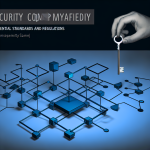
Security Compliance Demystified: Essential Standards and Regulations
July 21, 2025
From Frameworks to Enforcement: The Journey of Security Compliance
July 22, 2025
The rapid advancement of artificial intelligence (AI) is redefining various sectors, with cybersecurity standing out as a field undergoing a profound transformation. While AI offers the promise of enhanced security measures, it also presents unique challenges, making it a double-edged sword in our increasingly digital world.
The Promises of AI in Cybersecurity
Enhanced Threat Detection
AI technologies, such as machine learning and deep learning, are revolutionizing how organizations detect and respond to threats. Traditional cybersecurity methods often rely on predefined rules and signatures to identify malicious activities. In contrast, AI systems can analyze large volumes of data in real time, identifying patterns and anomalies that signify potential threats.
AI can enhance anomaly detection, quickly recognizing unusual behaviors in network traffic or user activity. With its ability to learn and adapt, AI can improve over time, becoming more effective at identifying new types of attacks.
Automation of Response
The speed at which cyber threats evolve necessitates rapid responses. AI can automate incident response processes, enabling organizations to react to threats more swiftly. For instance, when a potential threat is identified, AI systems can automatically isolate vulnerable systems, deploy patches, or implement countermeasures without human intervention, reducing the response time significantly.
Predictive Analytics
AI-powered tools can analyze historical data and predict future cyber threats. By recognizing trends and potential vulnerabilities, organizations can proactively bolster their defenses before an attack occurs. Predictive analytics also helps in resource allocation, enabling security teams to prioritize areas that require immediate attention.
24/7 Monitoring
With the help of AI, organizations can maintain constant vigilance over their networks. AI systems can monitor for threats round-the-clock, alleviating the burden on human security teams and allowing them to focus on more complex issues and strategic planning.
The Risks of AI in Cybersecurity
Sophisticated Cyber Attacks
While AI strengthens cybersecurity, it also equips cybercriminals with powerful tools to launch sophisticated attacks. Attackers can deploy AI algorithms to automate phishing campaigns, making them more efficient and harder to detect. As these AI systems improve, they can bypass traditional security measures, posing significant challenges for organizations.
AI-Powered Manipulation
AI can also be utilized for social engineering attacks. Advanced deepfake technologies, for example, enable malicious actors to create realistic audio and video content to deceive individuals or organizations. This manipulation can lead to unauthorized access, identity theft, or financial fraud.
Compliance and Ethical Concerns
The implementation of AI in cybersecurity raises ethical questions regarding privacy and data protection. Organizations must balance the need for security with the obligation to protect sensitive user data. Additionally, the reliance on AI can lead to compliance issues as regulations evolve to address emerging technologies.
Over-reliance on AI
As organizations increasingly adopt AI solutions, there is a risk of over-reliance on technology. Security teams may become complacent, trusting AI systems to manage threats without adequate human oversight. This dependency can lead to significant vulnerabilities if the AI system fails or is manipulated.
Striking the Right Balance
To leverage AI effectively in cybersecurity, organizations must adopt a holistic approach that encompasses both technological and human elements. Training and upskilling security professionals to work alongside AI systems will be vital. Human expertise is irreplaceable, especially when it comes to contextualizing and interpreting AI-generated findings.
Additionally, organizations should implement ethical guidelines and frameworks governing AI use in cybersecurity. By prioritizing transparency and accountability, businesses can mitigate the risks associated with AI while maximizing its benefits.
Conclusion
The fusion of AI and cybersecurity represents a pivotal moment in our digital landscape. While AI enhances threat detection, response automation, and predictive analytics, it also introduces new vulnerabilities and ethical concerns. As we continue to navigate this evolving landscape, finding a balance between harnessing AI’s potential and remaining vigilant against its risks will be crucial in shaping a secure digital future. The journey is fraught with challenges, but with informed strategies and responsible practices, we can unlock the true potential of AI in cybersecurity.







